Guangming Wang
InfraDiffusion: zero-shot depth map restoration with diffusion models and prompted segmentation from sparse infrastructure point clouds
Sep 03, 2025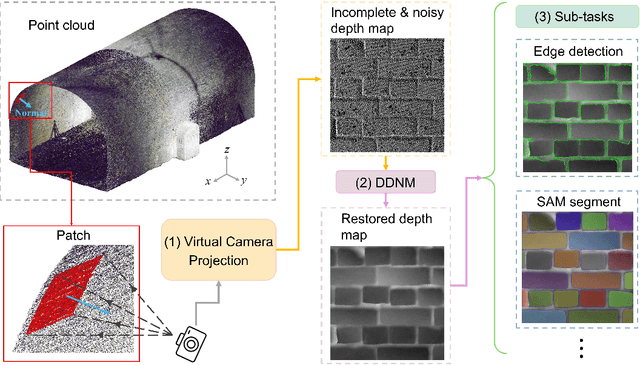
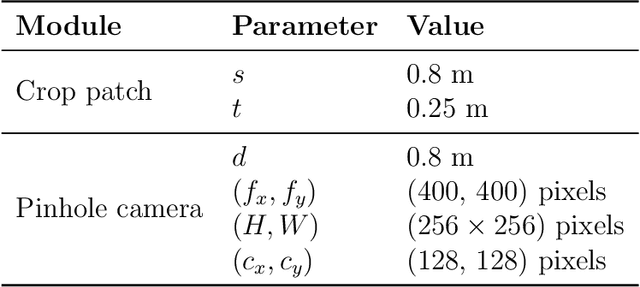
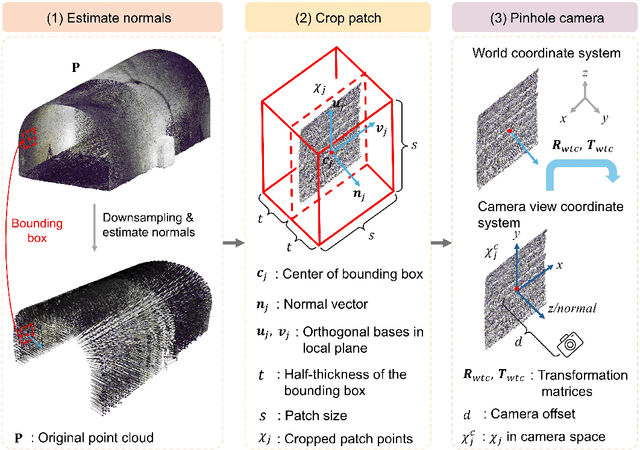
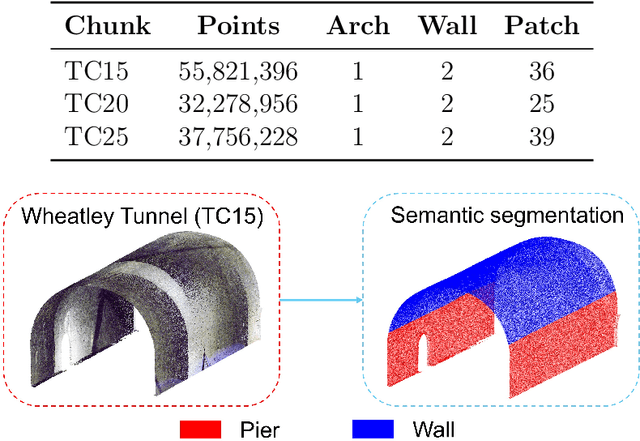
Abstract:Point clouds are widely used for infrastructure monitoring by providing geometric information, where segmentation is required for downstream tasks such as defect detection. Existing research has automated semantic segmentation of structural components, while brick-level segmentation (identifying defects such as spalling and mortar loss) has been primarily conducted from RGB images. However, acquiring high-resolution images is impractical in low-light environments like masonry tunnels. Point clouds, though robust to dim lighting, are typically unstructured, sparse, and noisy, limiting fine-grained segmentation. We present InfraDiffusion, a zero-shot framework that projects masonry point clouds into depth maps using virtual cameras and restores them by adapting the Denoising Diffusion Null-space Model (DDNM). Without task-specific training, InfraDiffusion enhances visual clarity and geometric consistency of depth maps. Experiments on masonry bridge and tunnel point cloud datasets show significant improvements in brick-level segmentation using the Segment Anything Model (SAM), underscoring its potential for automated inspection of masonry assets. Our code and data is available at https://github.com/Jingyixiong/InfraDiffusion-official-implement.
ERMV: Editing 4D Robotic Multi-view images to enhance embodied agents
Jul 23, 2025Abstract:Robot imitation learning relies on 4D multi-view sequential images. However, the high cost of data collection and the scarcity of high-quality data severely constrain the generalization and application of embodied intelligence policies like Vision-Language-Action (VLA) models. Data augmentation is a powerful strategy to overcome data scarcity, but methods for editing 4D multi-view sequential images for manipulation tasks are currently lacking. Thus, we propose ERMV (Editing Robotic Multi-View 4D data), a novel data augmentation framework that efficiently edits an entire multi-view sequence based on single-frame editing and robot state conditions. This task presents three core challenges: (1) maintaining geometric and appearance consistency across dynamic views and long time horizons; (2) expanding the working window with low computational costs; and (3) ensuring the semantic integrity of critical objects like the robot arm. ERMV addresses these challenges through a series of innovations. First, to ensure spatio-temporal consistency in motion blur, we introduce a novel Epipolar Motion-Aware Attention (EMA-Attn) mechanism that learns pixel shift caused by movement before applying geometric constraints. Second, to maximize the editing working window, ERMV pioneers a Sparse Spatio-Temporal (STT) module, which decouples the temporal and spatial views and remodels a single-frame multi-view problem through sparse sampling of the views to reduce computational demands. Third, to alleviate error accumulation, we incorporate a feedback intervention Mechanism, which uses a Multimodal Large Language Model (MLLM) to check editing inconsistencies and request targeted expert guidance only when necessary. Extensive experiments demonstrate that ERMV-augmented data significantly boosts the robustness and generalization of VLA models in both simulated and real-world environments.
MovSAM: A Single-image Moving Object Segmentation Framework Based on Deep Thinking
Apr 09, 2025Abstract:Moving object segmentation plays a vital role in understanding dynamic visual environments. While existing methods rely on multi-frame image sequences to identify moving objects, single-image MOS is critical for applications like motion intention prediction and handling camera frame drops. However, segmenting moving objects from a single image remains challenging for existing methods due to the absence of temporal cues. To address this gap, we propose MovSAM, the first framework for single-image moving object segmentation. MovSAM leverages a Multimodal Large Language Model (MLLM) enhanced with Chain-of-Thought (CoT) prompting to search the moving object and generate text prompts based on deep thinking for segmentation. These prompts are cross-fused with visual features from the Segment Anything Model (SAM) and a Vision-Language Model (VLM), enabling logic-driven moving object segmentation. The segmentation results then undergo a deep thinking refinement loop, allowing MovSAM to iteratively improve its understanding of the scene context and inter-object relationships with logical reasoning. This innovative approach enables MovSAM to segment moving objects in single images by considering scene understanding. We implement MovSAM in the real world to validate its practical application and effectiveness for autonomous driving scenarios where the multi-frame methods fail. Furthermore, despite the inherent advantage of multi-frame methods in utilizing temporal information, MovSAM achieves state-of-the-art performance across public MOS benchmarks, reaching 92.5\% on J\&F. Our implementation will be available at https://github.com/IRMVLab/MovSAM.
3D Gaussian Splatting in Robotics: A Survey
Oct 16, 2024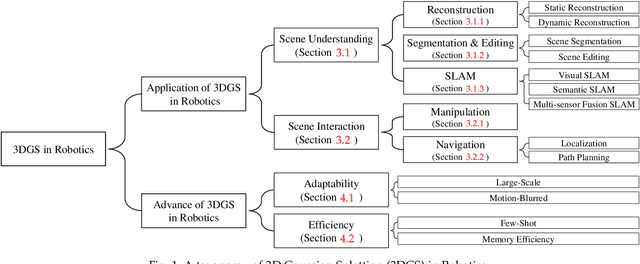


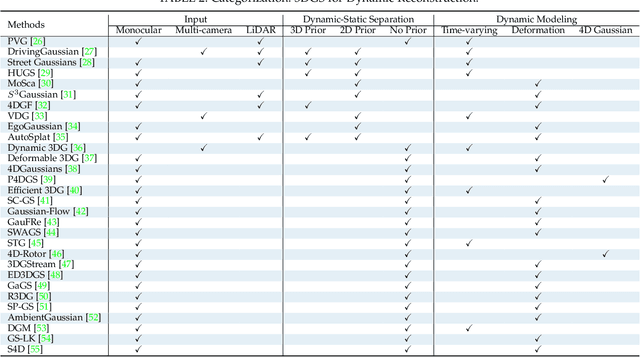
Abstract:Dense 3D representations of the environment have been a long-term goal in the robotics field. While previous Neural Radiance Fields (NeRF) representation have been prevalent for its implicit, coordinate-based model, the recent emergence of 3D Gaussian Splatting (3DGS) has demonstrated remarkable potential in its explicit radiance field representation. By leveraging 3D Gaussian primitives for explicit scene representation and enabling differentiable rendering, 3DGS has shown significant advantages over other radiance fields in real-time rendering and photo-realistic performance, which is beneficial for robotic applications. In this survey, we provide a comprehensive understanding of 3DGS in the field of robotics. We divide our discussion of the related works into two main categories: the application of 3DGS and the advancements in 3DGS techniques. In the application section, we explore how 3DGS has been utilized in various robotics tasks from scene understanding and interaction perspectives. The advance of 3DGS section focuses on the improvements of 3DGS own properties in its adaptability and efficiency, aiming to enhance its performance in robotics. We then summarize the most commonly used datasets and evaluation metrics in robotics. Finally, we identify the challenges and limitations of current 3DGS methods and discuss the future development of 3DGS in robotics.
RL-GSBridge: 3D Gaussian Splatting Based Real2Sim2Real Method for Robotic Manipulation Learning
Sep 30, 2024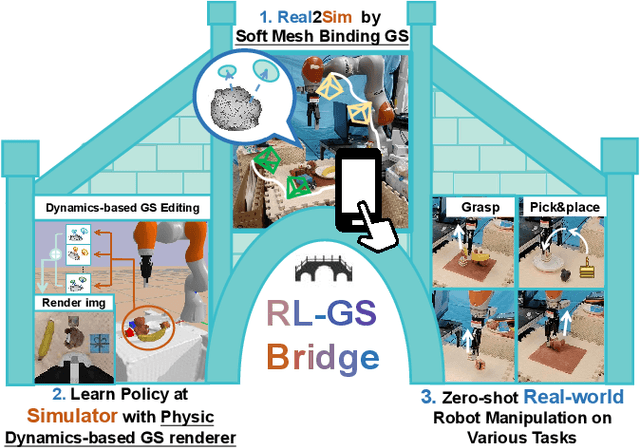
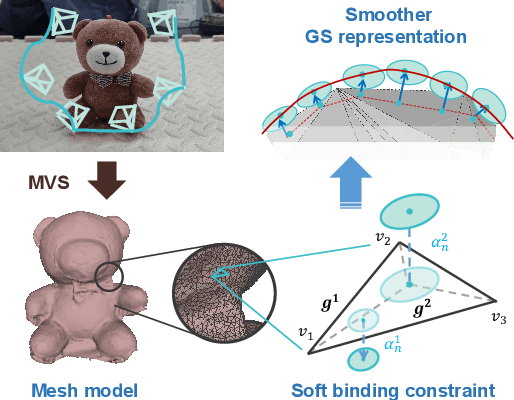
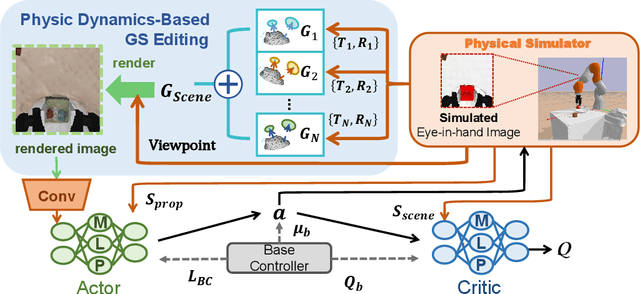

Abstract:Sim-to-Real refers to the process of transferring policies learned in simulation to the real world, which is crucial for achieving practical robotics applications. However, recent Sim2real methods either rely on a large amount of augmented data or large learning models, which is inefficient for specific tasks. In recent years, radiance field-based reconstruction methods, especially the emergence of 3D Gaussian Splatting, making it possible to reproduce realistic real-world scenarios. To this end, we propose a novel real-to-sim-to-real reinforcement learning framework, RL-GSBridge, which introduces a mesh-based 3D Gaussian Splatting method to realize zero-shot sim-to-real transfer for vision-based deep reinforcement learning. We improve the mesh-based 3D GS modeling method by using soft binding constraints, enhancing the rendering quality of mesh models. We then employ a GS editing approach to synchronize rendering with the physics simulator, reflecting the interactions of the physical robot more accurately. Through a series of sim-to-real robotic arm experiments, including grasping and pick-and-place tasks, we demonstrate that RL-GSBridge maintains a satisfactory success rate in real-world task completion during sim-to-real transfer. Furthermore, a series of rendering metrics and visualization results indicate that our proposed mesh-based 3D Gaussian reduces artifacts in unstructured objects, demonstrating more realistic rendering performance.
DSLO: Deep Sequence LiDAR Odometry Based on Inconsistent Spatio-temporal Propagation
Sep 01, 2024



Abstract:This paper introduces a 3D point cloud sequence learning model based on inconsistent spatio-temporal propagation for LiDAR odometry, termed DSLO. It consists of a pyramid structure with a spatial information reuse strategy, a sequential pose initialization module, a gated hierarchical pose refinement module, and a temporal feature propagation module. First, spatial features are encoded using a point feature pyramid, with features reused in successive pose estimations to reduce computational overhead. Second, a sequential pose initialization method is introduced, leveraging the high-frequency sampling characteristic of LiDAR to initialize the LiDAR pose. Then, a gated hierarchical pose refinement mechanism refines poses from coarse to fine by selectively retaining or discarding motion information from different layers based on gate estimations. Finally, temporal feature propagation is proposed to incorporate the historical motion information from point cloud sequences, and address the spatial inconsistency issue when transmitting motion information embedded in point clouds between frames. Experimental results on the KITTI odometry dataset and Argoverse dataset demonstrate that DSLO outperforms state-of-the-art methods, achieving at least a 15.67\% improvement on RTE and a 12.64\% improvement on RRE, while also achieving a 34.69\% reduction in runtime compared to baseline methods. Our implementation will be available at https://github.com/IRMVLab/DSLO.
Holistically-Nested Structure-Aware Graph Neural Network for Road Extraction
Jul 02, 2024Abstract:Convolutional neural networks (CNN) have made significant advances in detecting roads from satellite images. However, existing CNN approaches are generally repurposed semantic segmentation architectures and suffer from the poor delineation of long and curved regions. Lack of overall road topology and structure information further deteriorates their performance on challenging remote sensing images. This paper presents a novel multi-task graph neural network (GNN) which simultaneously detects both road regions and road borders; the inter-play between these two tasks unlocks superior performance from two perspectives: (1) the hierarchically detected road borders enable the network to capture and encode holistic road structure to enhance road connectivity (2) identifying the intrinsic correlation of semantic landcover regions mitigates the difficulty in recognizing roads cluttered by regions with similar appearance. Experiments on challenging dataset demonstrate that the proposed architecture can improve the road border delineation and road extraction accuracy compared with the existing methods.
NeRF in Robotics: A Survey
May 02, 2024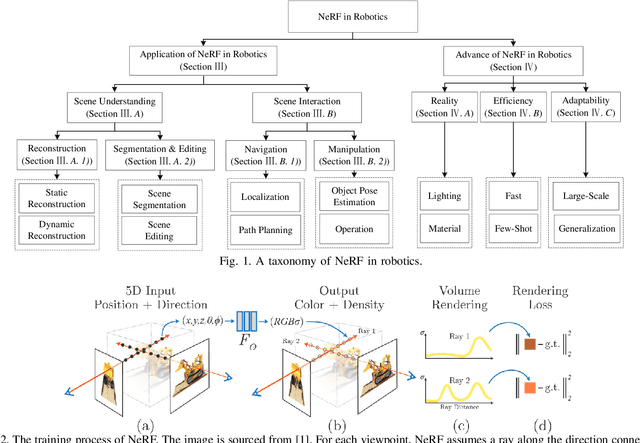

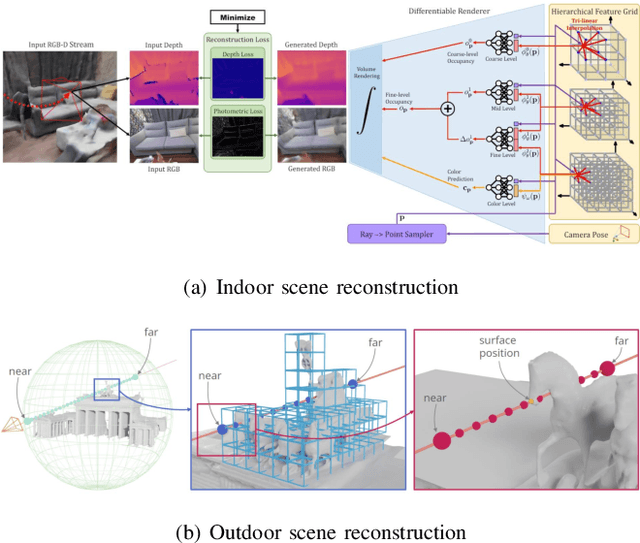
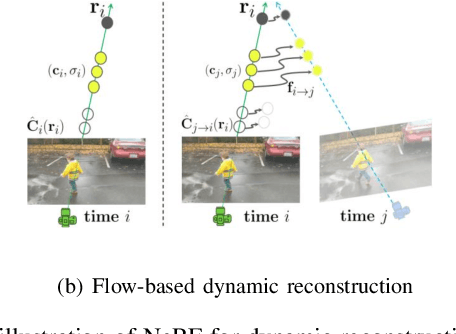
Abstract:Meticulous 3D environment representations have been a longstanding goal in computer vision and robotics fields. The recent emergence of neural implicit representations has introduced radical innovation to this field as implicit representations enable numerous capabilities. Among these, the Neural Radiance Field (NeRF) has sparked a trend because of the huge representational advantages, such as simplified mathematical models, compact environment storage, and continuous scene representations. Apart from computer vision, NeRF has also shown tremendous potential in the field of robotics. Thus, we create this survey to provide a comprehensive understanding of NeRF in the field of robotics. By exploring the advantages and limitations of NeRF, as well as its current applications and future potential, we hope to shed light on this promising area of research. Our survey is divided into two main sections: \textit{The Application of NeRF in Robotics} and \textit{The Advance of NeRF in Robotics}, from the perspective of how NeRF enters the field of robotics. In the first section, we introduce and analyze some works that have been or could be used in the field of robotics from the perception and interaction perspectives. In the second section, we show some works related to improving NeRF's own properties, which are essential for deploying NeRF in the field of robotics. In the discussion section of the review, we summarize the existing challenges and provide some valuable future research directions for reference.
EMIE-MAP: Large-Scale Road Surface Reconstruction Based on Explicit Mesh and Implicit Encoding
Mar 18, 2024

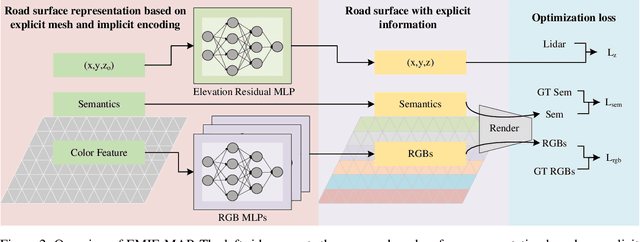
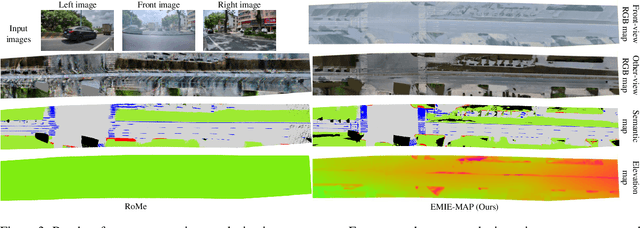
Abstract:Road surface reconstruction plays a vital role in autonomous driving systems, enabling road lane perception and high-precision mapping. Recently, neural implicit encoding has achieved remarkable results in scene representation, particularly in the realistic rendering of scene textures. However, it faces challenges in directly representing geometric information for large-scale scenes. To address this, we propose EMIE-MAP, a novel method for large-scale road surface reconstruction based on explicit mesh and implicit encoding. The road geometry is represented using explicit mesh, where each vertex stores implicit encoding representing the color and semantic information. To overcome the difficulty in optimizing road elevation, we introduce a trajectory-based elevation initialization and an elevation residual learning method based on Multi-Layer Perceptron (MLP). Additionally, by employing implicit encoding and multi-camera color MLPs decoding, we achieve separate modeling of scene physical properties and camera characteristics, allowing surround-view reconstruction compatible with different camera models. Our method achieves remarkable road surface reconstruction performance in a variety of real-world challenging scenarios.
DVN-SLAM: Dynamic Visual Neural SLAM Based on Local-Global Encoding
Mar 18, 2024Abstract:Recent research on Simultaneous Localization and Mapping (SLAM) based on implicit representation has shown promising results in indoor environments. However, there are still some challenges: the limited scene representation capability of implicit encodings, the uncertainty in the rendering process from implicit representations, and the disruption of consistency by dynamic objects. To address these challenges, we propose a real-time dynamic visual SLAM system based on local-global fusion neural implicit representation, named DVN-SLAM. To improve the scene representation capability, we introduce a local-global fusion neural implicit representation that enables the construction of an implicit map while considering both global structure and local details. To tackle uncertainties arising from the rendering process, we design an information concentration loss for optimization, aiming to concentrate scene information on object surfaces. The proposed DVN-SLAM achieves competitive performance in localization and mapping across multiple datasets. More importantly, DVN-SLAM demonstrates robustness in dynamic scenes, a trait that sets it apart from other NeRF-based methods.
 Add to Chrome
Add to Chrome Add to Firefox
Add to Firefox Add to Edge
Add to Edge